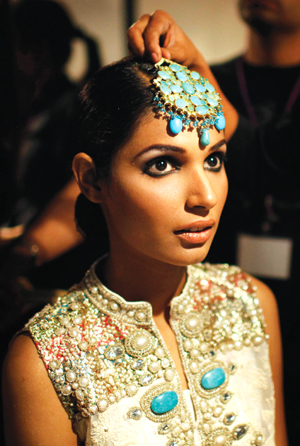By Chris Brummitt
The Associated Press

A model gets ready to display a creation by Pakistani designer Athar Hafeez during the Pakistan Fashion Week in Karachi on Nov. 5. The fashion week was delayed due to ongoing militant violence and security fears, which kept foreign guests away. (Photo by Alexandre Meneghini/AP)
KARACHI, Pakistan (AP) — Some women strode the catwalk in vicious spiked bracelets and body armor. Others had their heads covered, burqa-style, but with her shoulders — and tattoos — exposed. Male models wore long, Islamic robes as well as shorts and sequined T-shirts.
As surging militant violence grabs headlines around the world, Pakistan’s top designers and models are taking part in the country’s first-ever fashion week. While the mix of couture and high-street fashions would not have been out of place in Milan or New York, many designers reflected the turmoil, contradictions, and tensions coursing through the society.
The four-day event, which was postponed twice due to security concerns and in the midst of unease at hosting such a gathering amid an army offensive in the northwest, is aimed at showing the world that there is more to Pakistan than violence. It is helping to boost an industry that employs hundreds of thousands of people, organizers said.
Many of the models, designers, and well-heeled fashionistas packing out each night said the gathering was a symbolic blow to the Taliban and its vision of society, where women are largely confined to the house and must wear a sack-like covering known as a burqa.
“This is our gesture of defiance to the Taliban,” said Ayesha Tammy Haq, CEO of Pakistan Fashion Week.
“There is a terrible problem of militancy and political upheaval … but that doesn’t mean that the country shuts down. That doesn’t mean that business comes to a halt.”
The shows are taking place in Karachi, the country’s largest and most cosmopolitan city, in a five-star hotel just next door to the American consulate, which was bombed by Islamist militants in 2002. It is a two-hour flight from the northwest, the heartland of al-Qaida and the Taliban, and has largely been spared the violence which has been sweeping the country over the last month.
“Unfortunately, it is the bad side of Pakistan that gets everybody’s attention,” said top Pakistani model Nadia Hussain, as hairdressers and makeup artists fussed over her backstage. “It has never been this bad, I don’t know what will happen,” she said.
While many of the city’s 12 million people live in slums, hip cafes and restaurants in wealthy neighborhoods draw a sophisticated young crowd into the early hours, many of whom speak English and wear Western dresses.
While the shows in Karachi resembled other fashion weeks in other parts of the world, there were no foreign designers or buyers. The organizers decided not to invite them given the precarious security situation.
“Who is going to come here with such negative stuff going on?” said Tabassum Mughal, a young designer who employs about 30 people. “Those who are here already are leaving.”
Textiles make up some 60 percent of Pakistan exports and are worth around $12 billion dollars a year. The country’s cotton and silks are among the finest in the world. But the industry has failed to grow in recent years amid political unrest, violence, and chronic power shortages.
As if on cue, power was cut during the fashion week’s opening evening, leaving the hall in darkness for several minutes.
The fashion industry represents a tiny fraction of the country’s textile exports.
“We are still doing the 30 dollar a dozen T-shirt business. There is no value added,” said Haq. “We should be employing millions of people, not hundreds of thousands of them.”
Designers presented a mix of clothes, some drawing on traditional Pakistani outfits and tribal motifs. Others had little or no sign of traditional aesthetics. In a culture where most women dress modestly, many outfits were too racy for local tastes.
“This does not represent what we are as a people,” designer Ayesha Tahir Masood said. “Only 0.001 percent of Pakistani women would wear these clothes, and then only in a controlled environment when they are drunk out of their minds.” ♦



